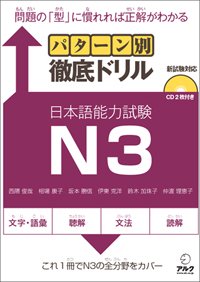The Japanese Language Proficiency Tests (JLPT) are divided into five levels with N5 being for beginners and N1 for upper advanced students. Each level takes a great deal of preparation, and this is even truer for the N2 and N1 exams (intermediate and upper advanced). In order to pass the N2 exam you are expected to be able to understand most everyday Japanese and be able to comprehend a variety of topics through reading or listening. An important feature when taking the JLPT exam is to be able to answer questions about grammar as well as grammar used in reading and listening tasks.
"This book can come in handy for anyone who doesn’t feel completely prepared for the grammar section of the exam and wants to prepare themselves before taking the JLPT test."
3A Corporation is a name that most students of Japanese will get used to seeing, they publish an impressive range of books aimed at students and the Master series focused on the JLPT exams is very well known. For each level they have created targeted books which cover the main areas of the exam paper, such as reading, grammar, vocabulary and listening. This particular Master book provides the student with grammar exercises. The book is written in both English and Japanese and the book is divided into 7 sections. Parts one to five are organized according to verb conjugation, part six focuses on particles and part seven on other grammatical structures.
After the initial sections of the book, the following chapters are pretty standard. A grammatical structure is introduced, the English meaning is given, information is provided on when and how to use it, and a couple of example sentences are provided. The student then has three to four exercises to complete and the exercises are in the same format as the questions in the JLPT exam. In each chapter there are also explanations about particular verb forms such as the passive, which is well known for causing difficulties for students learning any language. Every two or three lessons students will also come across comprehensive exercise sections of over twenty questions, almost like a review exam. Once the student reaches the end of the book, 120 grammatical structures will have been focuses on. At the end of the book students will come across part seven which consists of a hundred comprehension questions.

Preparing for the JLPT exams involve learning and understanding each grammar point and working on drills and repetition-based activities to reinforce comprehension and exam technique. Having said this, books such as this one are rather common and follow a similar format.
A positive feature about this book is that the grammar explanations are kept simple and short and there is more than enough practice provided for the student in each chapter. There isn’t anything particularly unique about this book, but I must mention that it is somewhat out of date in regards to the new JLPT levels. Nonetheless this book can still come in handy for anyone who doesn’t feel completely prepared for the grammar section of the exam and wants to prepare themselves before taking the JLPT test.




